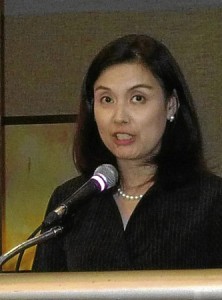Preventing the ‘sneak thief of sight’

PHILIPPINE Glaucoma Society officers, led by its president Veloso (3rd from left) and founder Aquino (5th from left), are in full force to welcome the upcoming World Glaucoma Week observance in the Philippines. PHOTO BY CHARLES E. BUBAN
Located at the back of our eyes are bundles of nerve fibers—called the optic nerves—that serve as communication cables between our eyes and our brain.
Within each of these 1.5mm- to 2.0mm-diameter strands are about 1.5 million exceptionally thin nerve fibers, which when affected by disease or subjected to trauma or excessive pressure could suffer irreversible damage.
One of the conditions that could injure the optic nerve is glaucoma, characterized by the gradual blurring of vision, especially at night, seeing halos or rainbows around lights, experiencing severe headaches or eye pain, nausea (although one type of glaucoma exhibits no symptom as the individual loses peripheral vision if not go completely blind without warning).
“Glaucoma is thought to be the primary reason for preventable loss of vision and in fact, statistics show that over 60.5-million people around the world suffer from the disease, of which 8.5 million of them are already blind in both eyes,” informed Philippine Glaucoma Society president Dr. Maria Imelda Yap-Veloso during the launch of World Glaucoma Week held at the Makati Shangri-La Hotel.
World Glaucoma Week will be celebrated between March 12 and 16.
She added that the No. 1 cause of bilateral permanent blindness in the Philippines is brought about by the increased pressure around the optic nerve.
No symptoms
“The most concerning fact about most types of glaucoma is that distinct from other causes of blindness, it is asymptomatic (no symptoms) until it may be too late,” she lamented.
But while glaucoma is described as the “sneak thief of sight” because of lack of any obvious symptoms, it is still possible to prevent the disease, noted Dr. Rainier Covar, member of the Philippine Glaucoma Society’s research committee.
“Early detection of the disease is crucial to effective management. Although glaucoma risk is universal, particular groups are at higher risk than others. Risk factors for glaucoma may include those over 45 years old, anyone with family members who have had glaucoma, a predisposition toward diabetes, or known eye problems such as high intraocular pressure,” Covar described.
In observance of the World Glaucoma Week, the Philippine Glaucoma Society members will conduct free eye checkups on select locations nationwide.
“World Glaucoma Week was established in response to the worldwide concern over the increasing number of people with glaucoma. If these people do not have the condition detected and treated right away, more people, including Filipinos, are at risk of going blind from this disease,” announced Dr. Mario Aquino, the founding president of Philippine Glaucoma Society,
He added that World Glaucoma Week aims to educate more people about how to assess their risk for glaucoma and to be aware of the importance of regular eye examinations and disease detection.
Comprehensive exam
“Although there are glaucoma eyedrops that could aid in reducing the risks that elevate eye pressure, one has to undergo comprehensive eye exams first (must be conducted by an ophthalmologist) as this is the only way to detect glaucoma in its early stages. As a general rule, have comprehensive eye exams every three to five years after age 40 and every year after age 60. You may need more frequent screenings if you have glaucoma risk factors,” Covar suggested.
There are several tests that an ophthalmologist could perform including tonometry, a simple, painless procedure that measures one’s intraocular pressure.
Another is one that checks the fibers in one’s optic nerve. Here, the eye doctor employs instruments that look directly through the pupil to the back of the eye. This can reveal slight changes that may indicate the beginnings of glaucoma.
A visual field test could also be done to check whether the visual field has been affected by glaucoma, (the doctor uses a special test that evaluates peripheral vision).
Veloso said a comprehensive test would cost about P500 to about a few thousands, depending on clinics or hospitals.
“Remember early detection is vital to stopping the progress of the disease as there is no cure for glaucoma, yet. However, medication or surgery can slow or prevent further vision loss. This upcoming observance of the World Glaucoma Week is significant to every Filipino as our ranks will join forces to help more Filipinos preserve their sight,” Veloso said.















